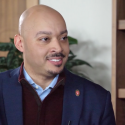Amasino receives prestigious HHMI professorship
Just as a non-musician savors the resounding strains of a Beethoven symphony, University of Wisconsin–Madison biochemist Richard Amasino believes that non-scientists can appreciate the role of science in their lives.
Recently named a Howard Hughes Medical Institute professor, Amasino plans to use his appointment to develop a new line of plant mutants and educational material to teach genetic principles to grade- and high-school students – and, he hopes, help cultivate a generation that values science.
“We’d be better off as a society if people knew more about science, what it is, what it can do, and what it can’t do,” says Amasino, a professor of biochemistry whose lab is trying to understand how plants respond to seasonal cues to determine when to flower. “We’d make better decisions as a society if we understood science better.”
The Howard Hughes Medical Institute, based in Chevy Chase, Md., is a nonprofit medical research organization dedicated to discovering and disseminating knowledge in the basic life sciences. HHMI professors are leading research scientists who, through their teaching and mentoring, are striving to ignite the scientific spark for a new generation of students. Amasino is one of 20 scientists who were awarded the designation on Wednesday, April 5. He and the other HHMI professors will each receive $1 million to put innovative ideas into action.
“The scientists whom we have selected are true pioneers – not only in their research, but in their creative approaches and dedication to teaching,” says Thomas R. Cech, HHMI president. “We are hopeful that their educational experiments will energize undergraduate science education throughout the country.”
Amasino’s lab uses Arabidopsis, part of the mustard family, as a model organism to study the genes that control what time of year that plants flower. However, while Arabidopsis works well for basic research, its small seeds and flowers limit its application in the classroom, where plants should ideally be easy to work with and cycle rapidly from seed to flower and back to seed.
That’s why Brassica rapa, a related plant, is more suitable for classroom use, and has found a niche as a plant-biology teaching tool in science classrooms – through efforts such as the widely successful Fast Plants program by UW–Madison plant pathologist Paul Williams – because of its rapid life cycle and convenient size.
Amasino believes that rapid-cycling versions of Brassica rapa could be used to teach a broad range of genetics principles if strains were developed with new mutants and the ability to self-pollinate. He envisions using the plants to teach the fundamentals of genetics – from molecular to biochemical, developmental and classical genetics – to kindergarten through high-school students. With his HHMI professorship, Amasino will gear up his lab to generate the new mutants, as well as related teaching materials, and distribute them to science teachers across the country.
“I’ve always been concerned about science education, and making it better,” says Amasino. “At one level, science education should be a lot of fun, but unless you have the right materials and teachers with the right knowledge, it isn’t always something students enjoy.”
He is quick to add he feels that scientists ultimately play an important role in the resources available to students.
“When I see dedicated teachers who don’t understand science, I look in the mirror and wonder how scientists can do a better job of helping them.”
In addition to his outreach work, Amasino welcomes undergraduates into his lab, and plans to involve biochemistry majors as well as science education majors from the School of Education in projects as the work progresses. “I like to give undergrads the opportunity to work in my lab, because there’s a big difference between doing science and reading about it,” he says.
And while he acknowledges that the exercises he develops might spark the imagination of future scientists, he says that he is most concerned with reaching the students who have no interest in pursuing science as a career.
“If there is one group I could target, it would be the people who won’t become scientists, because as a society we’d make better decisions if more people appreciated science and enjoyed it. I love music, although I’m not a musician. That’s what I want for science – and to get there, we need help in terms of education.”
Tags: biosciences



